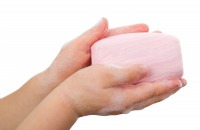We all use soap several times a day, yet few of us have ever actually given thought to where it comes from and how soap came to be in the first place.

It turns out that the history of soapmaking is a bit of a mystery because of the many different stories that have surfaced over the centuries.
The earliest evidence of soapmaking that we know of comes from Egypt in 1550BC as indicated in Ebers papyrus showing that Egyptians bathed using a combination of vegetable and animal oils, and alkaline salts which created a soap type of substance.
Though there is evidence of the Egyptians making soap, the Roman history of soapmaking also provides us with some colorful stories that have led many to believe that they were responsible for both manufacturing soap as well as naming it.
One such story is that soap got its name from a place called “Mount Sapo”. Story has it that Mount Sapo was where animal sacrifices took place and the tallow, ashes and water produced soap. The funny thing about this story is that there is no evidence of a place called Mount Sapo in the Roman world. All we do know for certain about the name is that sapo means soap.
More tidbits about the history of soapmaking

- There is even Biblical evidence that suggests the Israelite people mixed ashes with vegetable oils to make a product that resembles hair gel. It was in the second century AD that a famous physician called Galens recommended people as well as his patients use soap to keep clean and as a topical ointment for skin diseases.
- The remains of a soap factory were found in the ruins of Pompeii where a batch of soap was also discovered. The Gauls and ancient Germans made soap out of ashes mixed with fat from animals and used it to decorate their hair. It was in the Renaissance period that Europeans began using soap to clean their bodies and after this soap was widely used for personal hygiene. To date, its chemical formula has not changed that much at all.
- American colonists made soap much the same way as people did in the Renaissance. The process used in those days was repeated by soapmakers who would collect lye by dripping water through ashes from different woods. They would then mix this lye with animal or vegetable fat to make their soap.
- Over the centuries the soapmaking process did not change at all but the next real development was when Castile soap was produced. This was soap made from the saponification of olive oil. The end product was so much better because it was less caustic. The ingredients used excluded wood ash or rank goats tallow.
- Castile soap was nicer to work with and it formed solid bars of soap. It could be shredded and then molded so soap balls came into being. Soap during this period of time was considered to be a luxury item and was taxed accordingly.
- Over time herb and plant essences became part of the history of soapmaking were introduced into soap recipes because it was believed these had valuable medicinal properties that cured and prevented certain common illnesses. Some of the plant essences used to produce soap were in fact quite dangerous.
Then there were 3 major changes in how soap was produced.
- The production of caustic soda which is an essential ingredient in modern soapmaking.
- In the 20th century when the syndet bar (synthetic detergent) was introduced onto the market.
- The ancient skills used in the making of Castile soap were rediscovered then updated which has led to the handcrafted soaps we find on the market today.
